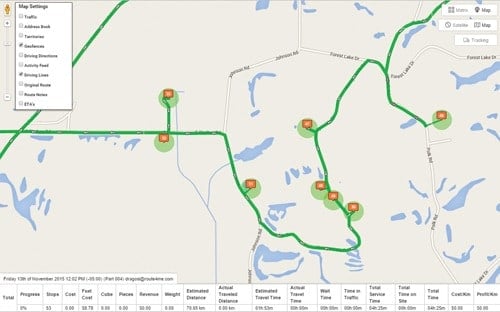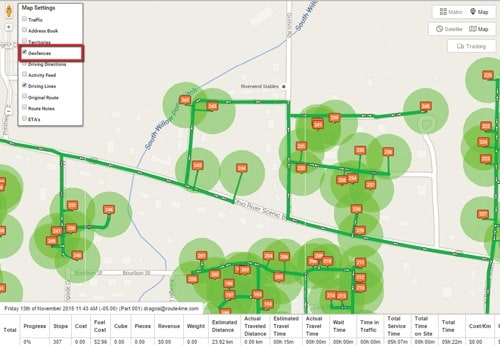Cutting transportation costs down to size can dramatically impact your bottom line. But to do it, a route planning app must not only have the right features, but also fit your needs specifically.
By Bjorn Orvar

Photos courtesy of Route4Me.
What John saw while closing his company’s books in 2015 troubled him. His waste management business had made a profit last year, but expenses had gone up more than expected. The company’s transportation costs, in particular, had gone up significantly despite lower fuel prices. John knew a fleet of trucks would be costly in 2015. He didn’t realize just how costly it would be until he saw it in black and white. If he could cut transportation costs, he’d boost profitability significantly in 2016.
John’s problem is not uncommon in the waste management industry. Operating a fleet of trucks is costly—no matter how many trucks in a fleet. Statistics from an infographic created by TruckersReport.com tells us how costly it is. In fact, the cost of operating one truck in the U.S. per year is about $180,000. Now multiply these costs by a fleet of six or seven trucks and you get the idea. But how do you cut transportations costs without driving up expenses elsewhere?
Cutting Transportation Costs
Savvy waste management companies cut transportation costs with good route planning. It can save a company thousands each year. But many companies in the industry still create routes manually using pencil and paper or Excel spreadsheets. That’s expensive and time-consuming. More importantly, it results in non-optimized routes, which boost vehicle costs, delay customer service and limit employee productivity. They also limit a manager’s ability to handle unexpected changes or events.
A better way to create good routes is with route planning software. Using route planning software to automatically create routes cuts costs without having to invest a lot in expensive equipment. And it can cut costs rather significantly—sometimes by as much as 10 to 20 percent. Route planning software provides other benefits as well. It increases productivity, improves customer service and saves hours of planning time—time you can devote to more pressing matters.
Cutting Costs With Route Optimization
However, to benefit from route planning software, you need to create optimized routes, which the software can do if it has a powerful route optimization engine. Ideal for routes with more than 10 stops per route, route optimization creates the most efficient routes possible while accounting for details, like when drivers leave for the landfill, when they start their collection runs and when they take lunch. To create good routes, a route optimization engine tests billions of scenarios in less than a minute until it finds the optimal ones.
Route optimization saves fuel, equipment and labor costs. And it does so no matter what the fleet’s size. Of course, smaller fleets might take a little longer to realize these savings, but they eventually come. If the route planning solution also contains features, like geo-fencing and automatic check-in/check-out, it can help a company cut transportation costs dramatically, sometimes by as much as 30 percent or more.
But that’s not all. Optimizing your routes generates the kind of benefits that can transform your company, like boosting profitability. Put simply, route optimization can help you add new customers without boosting prices. A good route planning app with a powerful optimization engine can also help you handle the unexpected changes or delays your drivers often face on collection runs.
Find One That Fits You Needs
To enjoy the benefits of route optimization, you first need to find a good route planning app—one with the right route optimization engine. But with dozens of route planning apps available, how do you choose the right one? To start, you’ll want an app that’s cloud-based and that syncs with your smartphone or tablet, be it an iPhone, iPad or Android device. These features save you both time and money. Below are seven other features you’ll want in a good route planning software solution:
Individual driver routing—This feature squeezes the most out of your drivers by providing control of their activities. Controlling driver activity not only saves time and money, but also increases driver productivity, which in turn boosts profitability.
Distributed team routing—Do you have multiple drivers to plan routes for and manage? This feature cuts the job down to size. With it, you can manage your team more efficiently and effectively, freeing up employee time you can apply to more pressing matters.- Projected ETAs—Customers hate waiting for anything. But you can make waiting easier for customers with this feature. It tells you exactly when drivers will arrive at a location, so you can let customers know when to expect them. Knowing when a driver will arrive is something every customer appreciates.
- Real-time tracking—Things don’t always go as planned, especially when it comes to route schedules. Accidents, road construction, vehicle breakdowns—all can delay your drivers. Real-time tracking tells you where your drivers are and when they’ll arrive at a stop.
Auto-change synchronization—Mobile devices can increase driver productivity. This feature takes driver productivity to another level by automatically syncing Web site actions with major mobile devices. Syncing gives you a chance to integrate activities without investing in expensive hardware.- Reporting and analytics—These capabilities are essential to running an operation efficiently and effectively. After all, you can’t manage what you can’t measure. Route planning software with these capabilities lets you delve deeply into a business’s operations.
- Dynamic geo-fencing—Many managers consider this feature a game changer. It eliminates the need for drivers to check in and out of locations manually, saving time and cutting costs. It’s ideal for situations where drivers have multiple stops per route.

Also, look for a route planning app that’s backed by outstanding service and support to address problems when they occur, which can save you time and money as well.
Impact Your Bottom Line
Make no mistake. Operating a fleet of trucks in the waste management industry is costly—and it won’t be getting any cheaper. It can derail a budget and drain profits from a company. But route planning software can help cut transportation costs down to size by creating optimized routes for your fleet.
Cutting transportation costs down to size can dramatically impact your bottom line. But to do it, a route planning app must not only have the right features, but also fit your needs specifically. Choose wisely. | WA
A graduate of the Vancouver Film School, Bjorn Orvar is Vice President of Marketing at Route4Me Inc. (Fort Lee, NJ), used by thousands of businesses around the world, and featured in Trulia, ActiveRain, and the Wall Street Journal. Bjorn is a seasoned business writer, with particular experience in business optimization, routing and operations research. He can be reached at (604) 506-5863 or via e-mail at [email protected].
